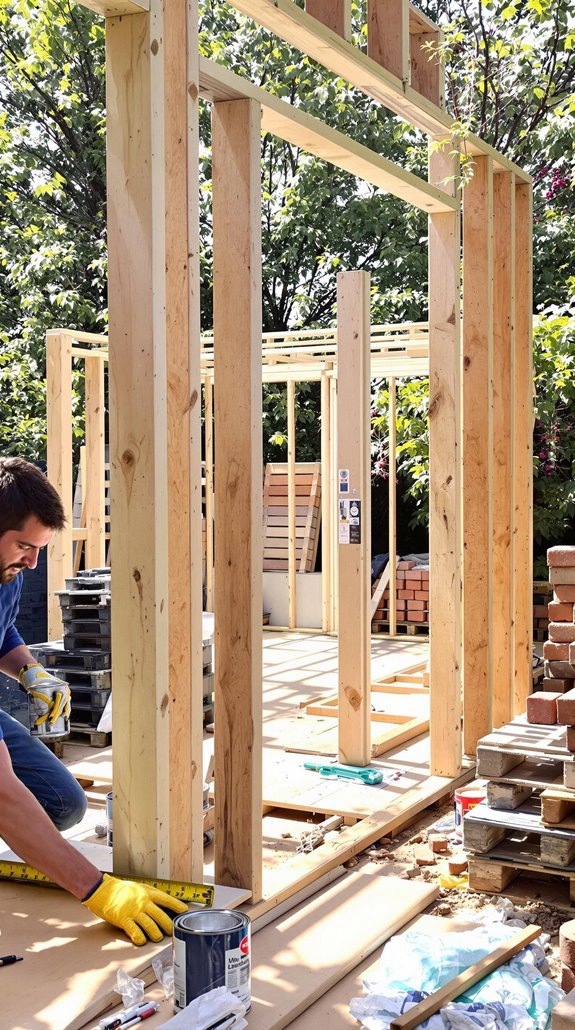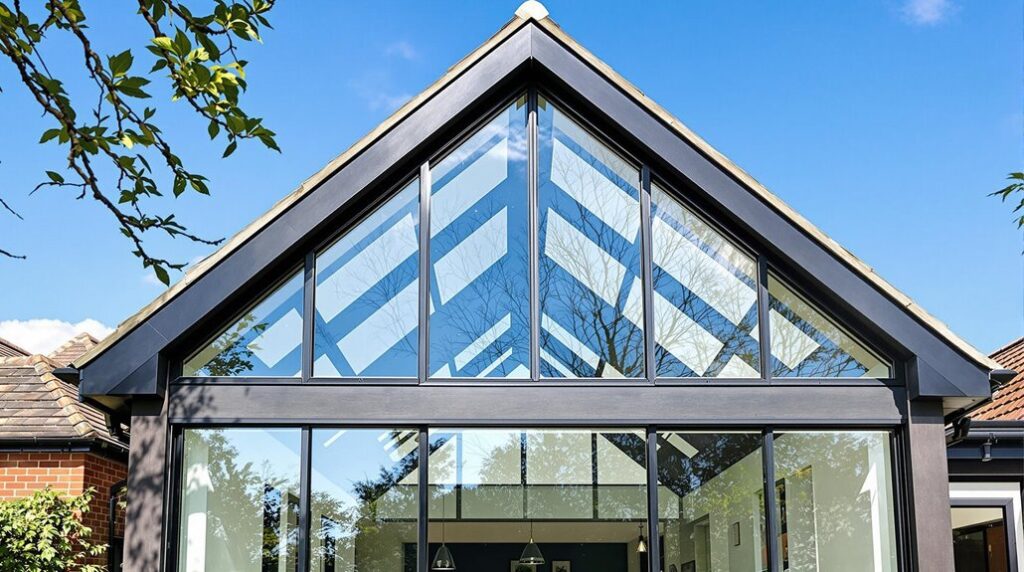I’ve helped dozens of homeowners add rooms without draining their savings accounts, and I’ll show you exactly how to do it. The key isn’t cutting corners on quality—it’s making strategic choices that slash costs while maximizing your investment. From sourcing materials at 60% off retail to finding skilled labor for half the price, these proven tactics will transform your space without breaking your budget. Here’s where most people make their biggest mistakes.
Key Takeaways
- Reduce square footage and focus on essential space to minimize materials, labor, and permit fees.
- DIY labor can save 35-50% of addition costs compared to hiring professional contractors.
- Source materials from demolition sites and salvage yards for 30-50% savings on supplies.
- Find skilled neighbors through local Facebook groups and hire trade school students for competitive rates.
- Consider attic conversions for cost-effective space expansion without expensive foundation work.
Limit Your Project Scope to Control Costs
When you’re planning a room addition on a tight budget, controlling your project scope becomes your most powerful cost-cutting tool. I’ll show you how to slash expenses by focusing on what truly matters.
First, reduce your square footage ruthlessly. Every foot you cut saves on materials, labor, and foundational work. Think essential space only – you’ll minimize permit fees and utility extensions too. A well-planned bedroom extension can maximize your existing space and enhance functionality without breaking the bank.
Next, avoid unnecessary features that inflate budgets. Skip custom built-ins, complex lighting schemes, and premium finishes during initial construction. You can always add these later.
Focus your budget on structural necessities: proper framing, electrical rough-in, and basic insulation. This approach keeps you within budget while creating a functional space you can enhance over time. Consider that attic conversions typically offer the most cost-effective solution since they utilize existing space without requiring new foundation work.
Tackle DIY Projects for Maximum Savings
Since labor costs typically represent 35-50% of any room addition project, taking on DIY work delivers your biggest opportunity for savings. I’ve seen homeowners save up to 83% by handling projects themselves rather than hiring professionals.
The numbers speak volumes: bedroom DIY averages $7,183 versus $22,130 for contractors—that’s $14,947 in your pocket. Kitchen remodels drop from $17,040 to $8,204 when you’re wielding the tools. Even bathroom projects shrink from $11,080 to $3,776 with DIY effort. Additionally, garage conversions can also be a smart way to add value and living space to your home.
You’re joining 73% of homeowners who choose DIY primarily for cost savings. Focus on projects within your skill level first—finishing basements, converting attics, or creating bump-outs. These maximize your savings while building confidence for larger undertakings. The average ROI for remodeling projects sits at 69%, making your DIY investment worthwhile.
Source Materials on a Tight Budget

While DIY labor cuts your biggest expenses, smart material sourcing can slash your remaining costs by another 30-50%. I’ll show you exactly where to find quality materials without breaking your budget.
Hit demolition sites and architectural salvage yards first – you’ll score reusable lumber, windows, and fixtures at 30-50% below retail. I’ve found incredible deals on vintage doors and tiles this way. Additionally, using cost-effective materials can significantly enhance your project’s affordability. Check contractor overstock and negotiate bulk pricing on leftover materials.
Don’t overlook online marketplaces like Craigslist and Facebook Marketplace for discounted supplies. Time your purchases around seasonal sales, and join contractor loyalty programs at building supply outlets for bulk pricing access. Choose cost-effective alternatives like laminate flooring ($0.50-$5/sq ft) over premium hardwood ($15/sq ft). If your material costs exceed your savings, consider personal loans with terms ranging from 36 to 60 months to spread the financial impact. Smart sourcing transforms your project budget.
Optimize Labor Costs With Smart Hiring
Finding the right workers at the right price transforms your room addition from a budget-buster into a manageable project. I’ll show you how to hire smart and stretch your labor budget.
Start by posting on local Facebook groups and Nextdoor – you’ll find skilled neighbors who charge less than big contractors. Check out trade school job boards where students need real-world experience and offer competitive rates. Don’t overlook retired tradespeople who work part-time for extra income. Additionally, consider reaching out to local removal companies that may have connections to affordable labor sources.
Focus on cultural fit during interviews. Workers who align with your project vision stay longer and work more efficiently. Ask about their experience with similar additions and request recent references.
Create clear job descriptions emphasizing transferable skills over fancy titles. Sometimes a handyman with the right attitude beats an overpriced specialist. Consider that skill-based recruitment strategies are becoming more effective than traditional hiring methods focused solely on credentials.
Maximize Space Efficiency Without Breaking the Bank
Smart hiring gets you the workforce, but clever design choices multiply your new space’s value without inflating costs. I’ll show you how to squeeze maximum function from every square foot.
First, calculate your space efficiency ratio—you’re targeting 60% living area versus total area. Use free floor plan software to test layouts before moving walls. Replace swing doors with pocket doors to reclaim 10 square feet per doorway. A garage conversion can also be a stylish and functional solution to enhance your living space.
Transform dead zones into goldmines. Convert oversized closets into compact offices or tackle that unfinished attic at 50% below new construction costs. Install Murphy beds and fold-down desks for instant room conversion.
Design hybrid spaces that serve dual purposes—guest bedroom doubles as home office. Add movable partitions instead of permanent walls. You’ll create flexible zones while keeping costs rock-bottom. Building up rather than out proves more cost-effective when you’re working with limited lot sizes.
Conclusion
I’ve shown you five practical strategies to add a room without draining your wallet. Start by defining your scope, then tackle what you can yourself. Hunt for discounted materials, hire smart to cut labor costs, and maximize every square foot. Follow these steps systematically, and you’ll create that extra space for 35-50% less than traditional methods. Your budget-friendly room addition is absolutely achievable with the right approach.
References
- https://normanbuilders.com/cost-of-home-addition/
- https://www.bankrate.com/homeownership/best-money-saving-diy-projects/
- https://www.lowcountryace.com/2024/09/27/diy-home-addition-cost/
- https://www.thisoldhouse.com/cabinets/21018036/21-ways-to-save-on-your-house-remodel
- https://www.mediumsizedfamily.com/the-dirty-details-of-home-addition-on-a-budget-step-two/
- https://legacyhomecarepro.com/2024/05/05/home-addition-cost-strategies-to-enhance-space-on-a-budget/
- https://www.nahb.org/subsites/log-homes/buyers-guide/budget-and-financing-pages/8-strategies-for-reducing-construction-costs
- https://www.birkesbuilders.com/blog/all/renovation-cost-control-strategies-save-money
- https://www.lamontbros.com/learning-center/home-addition-cost-breakdown
- https://www.homelight.com/blog/buyers-how-to-add-a-room-to-a-house-cheap/

